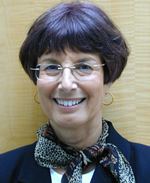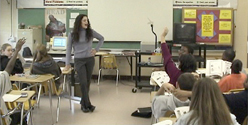
An electronic newsletter for the science education community
With Videos, New Views into Classroom Practice
In the following article, AAAS recently reported on Project 2061’s use of video cameras in its study of how to improve teaching and learning in middle grades mathematics. The study teams Project 2061 with researchers at the University of Delaware and Texas A&M University and involves nine school districts and 80 middle-school mathematics teachers.
Project 2061: Classroom Video Cameras Can Be Crucial In Teacher Training
|
At the first sight of the video camera, the classroom began buzzing with excitement. The students, who had cut their teeth on reality TV, wondered if they’d see themselves on television.
But the videotapes weren’t bound for MTV. Instead, they were headed to teacher-training classrooms and research sites as part of a five-year study by Project 2061, the AAAS mathematics and science education reform initiative.
Now celebrating its 20th anniversary, Project 2061 is named for the next year that Halley’s comet will pass by Earth. The forward-thinking initiative seeks to prepare K-12 educators and students for a time of technological and scientific advances. And judging by Project 2061’s most recent study, it is doing just that.
The study, “Improving Mathematics Teacher Practice and Student Learning through Professional Development,” involves nine school districts and 80 middle-school math teachers in Delaware and Texas.
Researchers are still analyzing the data, but several participants have already come to some eye-opening conclusions. “It was extremely enlightening,” said Laura Conner, a sixth-grade math teacher in Middletown, Del., who participated in the study.
Mathematical ideas take top-billing in all aspects of this study, as researchers work with teachers to examine the ways in which they try to help student learn those ideas. By watching videotapes, teachers recognized that they’d missed opportunities to question students, or that their questions were more about getting the task done than about developing understanding of important mathematics ideas.
They now focus on asking specific questions that respond to evidence of what their students are thinking about the mathematics, factor in common difficulties students may have, and move students toward a better understanding of the mathematics.
Viewing student responses on video also prompted teachers to pay closer attention to students’ problem-solving strategies. “There isn’t just one way to strategize and find the answer to a problem,” Conner explained. “There is an efficient way, but my most efficient way may not be the same as yours.” For the researchers, the underlying question is this: Can solving the problem lead to a deeper understanding of the mathematics?
That approach might puzzle baby boomers, who were taught that there’s just one way to tackle math. Focusing on the mathematical ideas, teachers take into account and build on a variety of different strategies that students might use to solve a problem.
To promote mathematics, science and technology literacy and reform, AAAS founded Project 2061 in 1985. In 1989, Project 2061 released “Science for All Americans,” which recommended the math and science skills that students should master before graduating high school.
Project 2061 later established learning goals, known as benchmarks, for specific grades. Educators nationwide now use the benchmarks to develop curriculum.
In 2000, Project 2061 analyzed 13 middle-grades math textbooks. “As we shared the information, people said, ‘That’s great, but what happens when the texts are in the teachers’ hands?’” said Kathleen Morris, senior program associate for Project 2061.
The question led to the current study, which was funded by the Interagency Education Research Initiative, a joint program of the U.S. National Science Foundation, the Department of Education and the National Institute of Child Health and Human Development.
To implement the study, Project 2061 partnered with the University of Delaware and Texas A&M University, both of which reside in states with established mathematics standards.
|
The study focused on four school districts in Delaware and five in Texas. Participating teachers used four of the 13 textbooks evaluated in Project 2061’s previous study. Two were highly rated, one was average and the last received a low rating.
Because the study was designed to look at the way in which key mathematics ideas are taught, researchers selected one benchmark from each of three areas: numbers, algebra and data.
Number lessons teach students to understand relationships among fractions, decimals, and percents; algebra lessons demonstrate the role of equations in showing how changing one quantity affects another; data lessons teach students about statistical information, including averages, spreads and medians. In all three areas, students learn to apply their knowledge to solving real world problems.
Before the first academic year began, teachers attended a two-day class to review the benchmarks and discuss the lessons that align with them. Then the videotaping started.
“At first it was a little nerve-wracking,” said Kathleen Wilson, an eighth-grade math teacher in Middletown, Del. “But you get used to it.” The students, too, soon found the experience “old hat,” Conner said.
Investigators — armed with a list of criteria for effective teaching — viewed the videotapes to determine topics for the professional development classes, which were held in summer. “We noticed there were some common problems,” said Jo Ellen Roseman, principal investigator for Project 2061.
For one, teachers weren’t adequately utilizing “representations,” including pie charts and number lines. Roseman recalled the video of a teacher who asked a child for the decimal equivalent of 1/2. When the student remained silent, the teacher followed with another abstract question rather than making use of a representation provided in the textbook to spur the student’s thinking process.
In another instance, a student attempted to represent the equivalence of 4/7 and 8/14. At the board, she opted for a rectangle representation to show that shading 4 out of 7 parts of a rectangle had the same area shaded as 8 out of 14 parts of a similar rectangle. When her second rectangle couldn’t accommodate 14 parts (because she had made the size of each part too big), she extended the rectangle, making the two rectangles unequal.
“It misses the point of the representation,” Roseman noted, which was to show that the fractions were equivalent because they could be represented by the same areas of similar rectangles. Because the class bell rang, the teacher missed an opportunity to determine whether students realized that the comparison was invalid and why. “We decided to use this excerpt during the professional development to engage teachers in considering what the teacher could have done to use the ‘mistake’ to focus students’ thinking on the concept of equivalence,” Roseman said.
Although teachers were asking the students plenty of questions, the teachers stopped once they heard a correct answer, rather than pressing students to explain their answers. Sixth-grade teacher Fred Ernst’s interactions with students averaged less than a minute. “I was shocked,” said Ernst, who retired this year from teaching public school in Camden, Del. He currently teaches a college class to education majors at Delaware State University.
Ernst, who came from what he called a “traditional background,” said he’d long made a point of incorporating Socratic questions and asking for student input. “I have been doing that, but not as much as I thought. I looked over videotapes from year one and year two and thought, ‘Oh, my.’”
Like Ernst, the other teachers watched their tapes to mark the moments that fit the investigators’ criteria for training topics.
Conner was astounded at what she saw in her sixth-grade class. “When you watch the entire class unfold, you can see and hear things that you don’t see when it’s happening,” she said.
Consider the class during which students seemed lost during a lesson on fractions. “What do we need to do to get them to solidify that idea?” Conner mused. Even highly rated textbooks don’t help teachers address student who get stuck, Roseman said.
Like Conner, another teacher had students who grew confused at one point. In a video clip, shown to colleagues in a professional development class, the teacher returned to a number line that had done the trick in the past. “He realized it was a powerful representation for them,” Roseman said.
Much of the development training was spent watching such videos clips. The experience was always constructive, never critical, Manon said. Conner agreed. “It was about the mathematics,” she said.
The professional development classes impacted the math lessons, Wilson said. “It was a full-blown lesson analysis, and we changed the lesson for the better.”
Since researchers filmed the same lessons over multiple years, they could chart the effect of the discussions and the videotape-viewing. By the third year, for instance, Ernest had expanded student interactions from an average of one minute to about three minutes each and expected students to explain their answers. “Slowly but surely, the tapes showed that I did that,” he said.
To determine how the teacher training affected student learning, investigators measured student outcomes with pre- and post-tests for each benchmark. “If there are great leaps in understanding from pre- and post-tests, we would expect to see improvements in the instruction,” Morris said. Investigators are seeking correlations between student test scores and teacher videos.
After amassing the data, Manon was impressed at the video camera’s potential in the classroom. “It captures the clarity of student thinking and promotes teacher reflection,” he said.
Like Wilson, many teachers would do it all again. “If it has all the right intentions — to improve teaching and learning — I wouldn’t mind it at all,” Wilson concluded.
Pam George
28 December 2005
What’s Ahead
Project 2061 researchers will finish analyzing the videotapes by the end of summer 2006. Over the next year, they will try to determine the correlation between the amount and type of professional development teachers received and improved student learning reflected by students’ performance on the assessments.
To find out more about how the researchers define quality teaching and assess student learning, read an overview of the study.
To learn more about the data analysis, read "Goals-Based Mathematics Study Produces Unique Data Set."
# # #
For more information about this study, please contact:
Senior Program Associate: Dr.
Kathleen Morris
Principal Investigator: Dr.
Jo Ellen Roseman, (202) 326-6666





